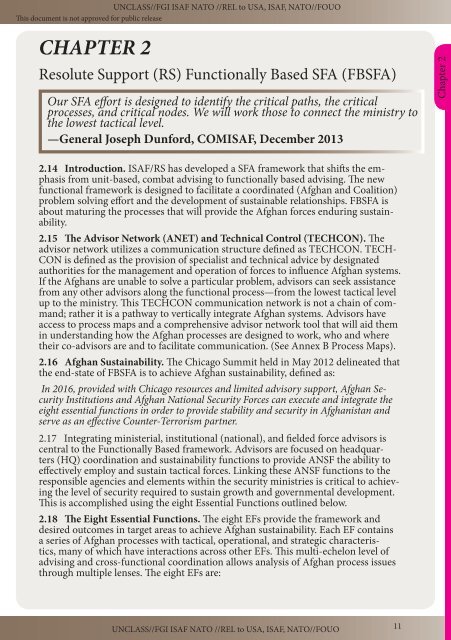20140927_NIU_CJ7_TREX_SFA guide 3.1
20140927_NIU_CJ7_TREX_SFA guide 3.1
20140927_NIU_CJ7_TREX_SFA guide 3.1
Create successful ePaper yourself
Turn your PDF publications into a flip-book with our unique Google optimized e-Paper software.
UNCLASS//FGI ISAF NATO //REL to USA, ISAF, NATO//FOUO<br />
This document is not approved for public release<br />
CHAPTER 2<br />
Resolute Support (RS) Functionally Based <strong>SFA</strong> (FB<strong>SFA</strong>)<br />
Our <strong>SFA</strong> effort is designed to identify the critical paths, the critical<br />
processes, and critical nodes. We will work those to connect the ministry to<br />
the lowest tactical level.<br />
—General Joseph Dunford, COMISAF, December 2013<br />
Chapter 2<br />
2.14 Introduction. ISAF/RS has developed a <strong>SFA</strong> framework that shifts the emphasis<br />
from unit-based, combat advising to functionally based advising. The new<br />
functional framework is designed to facilitate a coordinated (Afghan and Coalition)<br />
problem solving effort and the development of sustainable relationships. FB<strong>SFA</strong> is<br />
about maturing the processes that will provide the Afghan forces enduring sustainability.<br />
2.15 The Advisor Network (ANET) and Technical Control (TECHCON). The<br />
advisor network utilizes a communication structure defined as TECHCON. TECH-<br />
CON is defined as the provision of specialist and technical advice by designated<br />
authorities for the management and operation of forces to influence Afghan systems.<br />
If the Afghans are unable to solve a particular problem, advisors can seek assistance<br />
from any other advisors along the functional process—from the lowest tactical level<br />
up to the ministry. This TECHCON communication network is not a chain of command;<br />
rather it is a pathway to vertically integrate Afghan systems. Advisors have<br />
access to process maps and a comprehensive advisor network tool that will aid them<br />
in understanding how the Afghan processes are designed to work, who and where<br />
their co-advisors are and to facilitate communication. (See Annex B Process Maps).<br />
2.16 Afghan Sustainability. The Chicago Summit held in May 2012 delineated that<br />
the end-state of FB<strong>SFA</strong> is to achieve Afghan sustainability, defined as:<br />
In 2016, provided with Chicago resources and limited advisory support, Afghan Security<br />
Institutions and Afghan National Security Forces can execute and integrate the<br />
eight essential functions in order to provide stability and security in Afghanistan and<br />
serve as an effective Counter-Terrorism partner.<br />
2.17 Integrating ministerial, institutional (national), and fielded force advisors is<br />
central to the Functionally Based framework. Advisors are focused on headquarters<br />
(HQ) coordination and sustainability functions to provide ANSF the ability to<br />
effectively employ and sustain tactical forces. Linking these ANSF functions to the<br />
responsible agencies and elements within the security ministries is critical to achieving<br />
the level of security required to sustain growth and governmental development.<br />
This is accomplished using the eight Essential Functions outlined below.<br />
2.18 The Eight Essential Functions. The eight EFs provide the framework and<br />
desired outcomes in target areas to achieve Afghan sustainability. Each EF contains<br />
a series of Afghan processes with tactical, operational, and strategic characteristics,<br />
many of which have interactions across other EFs. This multi-echelon level of<br />
advising and cross-functional coordination allows analysis of Afghan process issues<br />
through multiple lenses. The eight EFs are:<br />
UNCLASS//FGI ISAF NATO //REL to USA, ISAF, NATO//FOUO<br />
11


